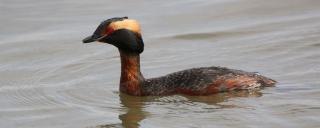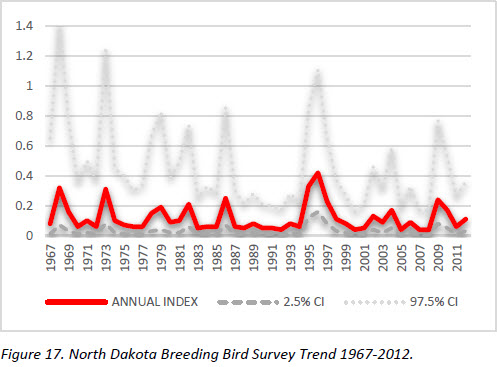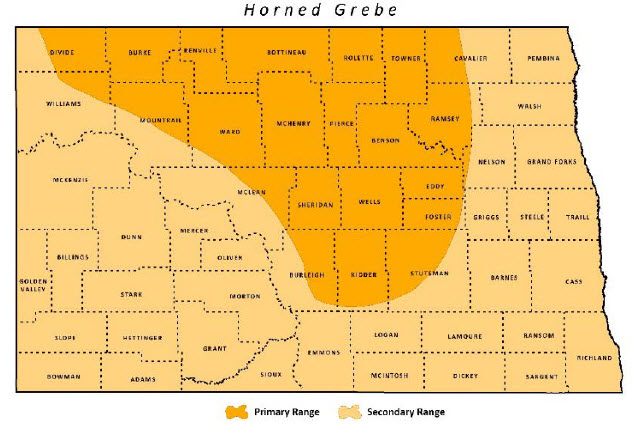
Horned Grebe
| Scientific Name | Podiceps auritus |
|---|---|
| General Description | L 14”, WS 18”, 1 lb. A straight black bill with a white tip, black head with solid yellow patch, reddish neck, and scaly gray back distinguish this grebe from the similar looking Eared Grebe. |
| Status | Occurs in North Dakota from April to November. Peak reeding season occurs from June to early August. |
| Abundance | Uncommon to fairly common. |
| Primary Habitat | Ponds and wetlands with beds of emergent vegetation and substantial areas of open water. |
| Federal Status | Migratory Bird. |
| Reason for Designation | Early records indicate this species was once much more common in North Dakota, found nearly everywhere on prairie wetlands. Designated as High Concern in the Northern Prairie and Parkland Waterbird Conservation Plan (NPPWCP) and High Concern by Waterbird Conservation for the Americas. Added to the USFWS Birds of Conservation Concern 2008 in Region 6, BCR11 and BCR17. Although possibly secure in North Dakota, it appears the Horned Grebe is declining overall throughout the Prairie Pothole Region and elsewhere. |
Locations and Conditions of Key Habitat
Preferred Habitat
Breeds in small (0.05 ha) to moderate-sized (1-10 ha), fairly shallow freshwater ponds and marshes with beds of emergent vegetation, particularly sedges, rushes, and cattails, and substantial areas of open water. Slightly brackish/alkaline water is also suitable. Nests are typically built over water on a floating platform of emergent vegetation. Artificial ponds and borrow pits may be used. Migration stopovers consist of mainly large-sized (1,000+ ha) bodies of water.
Key Areas and Conditions for Horned Grebe in North Dakota
Horned Grebes are fairly common in the Turtle Mountains and J.Clark Salyer, Upper Souris, and Des Lacs National Wildlife Refuges. The presence of this species varies greatly from year to year dependent on water availability.
Problems Which May Affect this Species
Habitat
Wetland destruction and/or degradation limits nesting habitat and food resources. The alteration of small wetlands to larger, more permanent wetlands could also impact this species.
Other Natural or Manmade Factors
Diet consists of primarily small fish (e.g. carp, darters, perch, and sticklebacks), but also aquatic invertebrates. Pollutants such as PCBs, mercury, and pesticides may limit the prey source or the bird itself directly. Collision with power lines over wetlands has been documented. Expanding oil and gas development in North Dakota increases risk of oilfield contamination of wetland habitat.
Research and Survey Efforts
Current Research or Surveys
- Rocky Mountain Bird Observatory (ND SWG T-40-R) is conducting a statewide inventory of colonial and semi-colonial waterbird populations and identifying key sites for breeding colonies in North Dakota. The Horned Grebe is one of 29 target species. The project was initiated in March 2014.
Previous Research or Surveys
- Northern Prairie Wildlife Research Center (ND SWG T-3-1 and T- 9-R) determined marsh bird distribution in relation to landscape composition in North Dakota. The project was initiated in 2004 and a final report provided in 2008. Horned Grebes were one of 16 focal species but were not detected during the surveys.
Additional Research or Surveys Needed
- More accurately estimate population distribution, size, and trend.
- Identify and target high priority habitats and landscapes or conservation action.
- Identify and protect key colonies and surrounding wetlands.
Population and Trend Estimates

- Waterbird Conservation for the Americas Population Estimate: 100,000- 1,000,000 individuals
- NPPWCP BCR11 Population Estimate: unknown
- North Dakota BBS Trend: see figure 17
- Survey-wide BBS Trend 1966-2012: -1.84
Management Recommendations
- Protect and maintain wetland complexes.
- Prevent encroachment of woody vegetation around wetlands.
- Limit residential development around and recreational use of wetlands.
- Utility development should follow the guidance of “Reducing Avian Collisions with Power Lines” including marking power lines and creating an Avian Protection Plan.
Monitoring Plans
Horned Grebes are under-represented by the BBS roadside survey technique due to the inconspicuous behavior of breeding adults. Nest searches provide the most complete census of breeding birds, but targeted roadside transects before sunset during May or July may be the most efficient. The NPPWCP has identified the basic elements of how a regional/continental waterbird monitoring program should be structured. Waterbird monitoring should follow recommendations of the Waterbird Conservation for the Americas and North American Bird Conservation Initiative ‘Opportunities for Improving Avian Monitoring’.
2005-2015 Progress
The Horned Grebe remains a Level I Species of Conservation Priority. Efforts to identify key sites for breeding areas are underway. Several State Wildlife Grant Projects (T2-9-R, T-18-R, T-27-HM) have contributed to habitat enhancement of wetlands for Horned Grebes and other wetland dependent birds.

Note: A listing of works consulted when compiling the information on this page may be found in the 2015 State Wildlife Action Plan.
